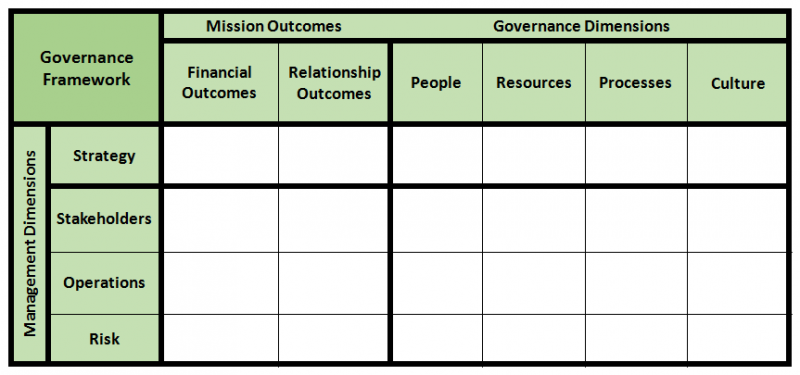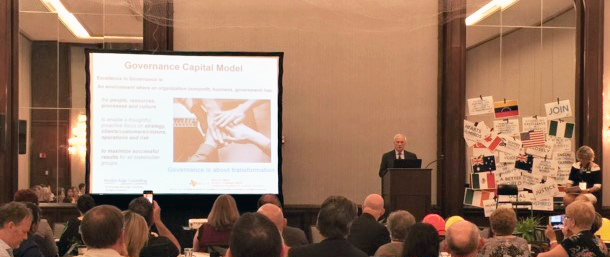The Governance Capital Model, presented by Vin Hoey as the keynote at a Govern for Impact (formerly International Association for Policy Governance) international conference in Savannah, GA. Vin represented the UT Dallas Institute for Excellence in Corporate Governance strategy committee, which developed the model.
Governance Capital Model for Nonprofits
The University of Texas at Dallas Institute for Excellence in Corporate Governance (IECG) has identified major trends in organization operating environments that have had a dramatic effect on governance in the past decade:
- Dynamic – increasing speed of change
- Distributed – stakeholders are spread out and control is spread around
- Networked – communications among stakeholders and public can take place graphically and rapidly
Changing environment
- Uncertain economic environment
- Changing government regulations
- Revisions in government funding
- Hyper-changes in science and technology
- Uncompromising demand for impact/results
- Calls for greater board diversity and transparency
- Social media and 24-hour news cycles

Usefulness for Nonprofits
To facilitate better governance, the University of Texas at Dallas Institute for Excellence in Corporate Governance strategy committee has developed an exciting new model. Governance capital is defined as “An environment where an organization has:
- the people, resources, processes and culture
- to enable a thoughtful, proactive focus on strategy, customers, operations and risk
- to maximize successful results for all stakeholder groups.”
The same model with adaptations, as needed, can be used in governance for businesses, nonprofits, government agencies and other organizations. For this blog post, I’ll apply it here to nonprofits.
The Governance Capital Model can be vitally useful as:
- An Assessment Tool – to help nonprofits evaluate the extent to which they have the right people, resources, processes and culture to achieve their mission outcomes. Identifying gaps can support continuous improvement and boost organization effectiveness.
- A Planning Tool – to use as part of a Strategic Planning process. Once a nonprofit’s strategic plan is developed and ready for board review, use of this Governance Capital Assessment could be especially helpful to prepare for Business Plan development. In our strategic planning work, we’ve often found that a nonprofit needs to strengthen its people, resources, processes and/or culture in order to effectively progress efficiently toward the chosen strategic direction, goals and objectives. The Governance Capital Assessment can help identify and prioritize what needs to be improved.
Governance Capital Mode

Governance Capital Assessment Process
- Identify board and management members to be involved in the assessment
- Share the process and outcomes ahead of time with participants
- Facilitate an in-person assessment with questions in each of the above sections on a 1 to 5 scale; in our experience, this can take two to three hours
The mission outcomes in the above model can come from a current or new strategic plan. The rest of the assessment in the Governance Dimensions above addresses:
- People – Right expertise in the Board, Senior Management, Staff and Volunteers to achieve Mission Outcomes
- Resources – Sufficient Funds, Assets, and External Partners that support achieving Mission Outcomes
- Processes – Formal processes that are Documented, Measured, and Reviewed to achieve Mission Outcomes
- Culture – Effective, self-governing culture that is Defined, Aligned, and Reinforced to achieve Mission Outcomes; culture is a key driver
Key Benefits of the Governance Capital Assessment
Key benefits are to:
- Help increase the rate of progress toward longer-range goals by identifying gaps in people, resources, processes and/or culture
- Develop a dashboard to set priorities and to measure progress
- Create alignment across the organization and address culture needs
- Support an organization at any stage in its lifecycle from early stage to preparing for more rapid growth to maturity
We believe that the greater the Governance Capital an organization has, the more likely it will succeed in achieving its mission and strategy outcomes. Identifying gaps can be helpful in prioritizing continuous improvement steps to expedite future progress.

